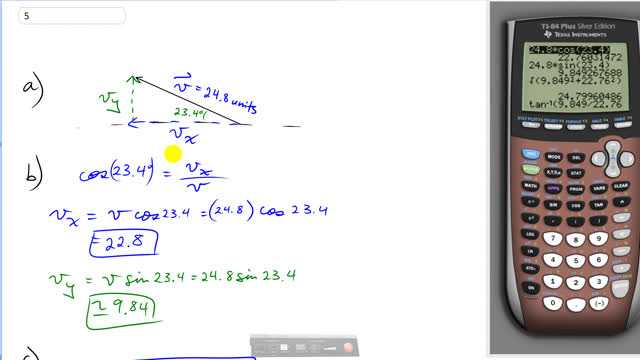
is a vector 24.8 units in magnitude and points at an angle of above the negative x axis.
- Sketch this vector.
- Calculate and .
- Use and to obtain (again) the magnitude and direction of . [Note: Part (c) is a good way to check if you've resolved your vector correctly.]

In order to watch this solution you need to have a subscription.
This is Giancoli Answers with Mr. Dychko. Here's a sketch of the vector, 24.8 units long and 23.4 degree angle above the negative x-axis and we have to find its x and y components. So cos of 23.4 is adjacent over hypotenuse and so that's v x over v and then rearrange that to solve for v x by multiplying both sides by v and we get this formula here. And we'll plug in the magnitude—24.8—times cos of 23.4 and we get 22.8 is the x-component of this vector. And likewise, for sin, we use sin for finding the y-component of the vector. So it's gonna be 24.8 times sin of 23.4 and we get 9.84 or 9.85 I guess I suppose— I should round that up maybe— for the y-component of the vector. And then in part (c), we are just working backwards again and making sure we get what we started with and so as a way to check to make sure we resolved the vector correctly here and we find the magnitude by taking the sum of the squares of the components and then take the square root of that and we get 24.8 which checks out— that's what the question tells us is the length, 24.8— and then the angle is the inverse tangent of the y-component divided by the x-component or inverse tangent of opposite over adjacent and we get 24 degrees and according to the drawing, that's above the x-axis and that checks out as well. Well, we got 23.4, we can make it have three significant figures, can't we? So 23.4 degrees above the x-axis, good.
Why isn't Vx negative? Since it is going in the negative direction?
yes i was wondering the same